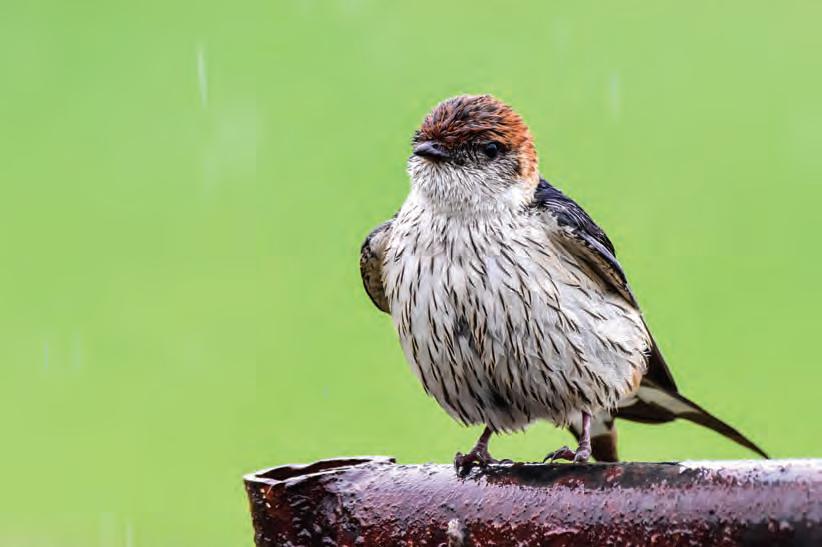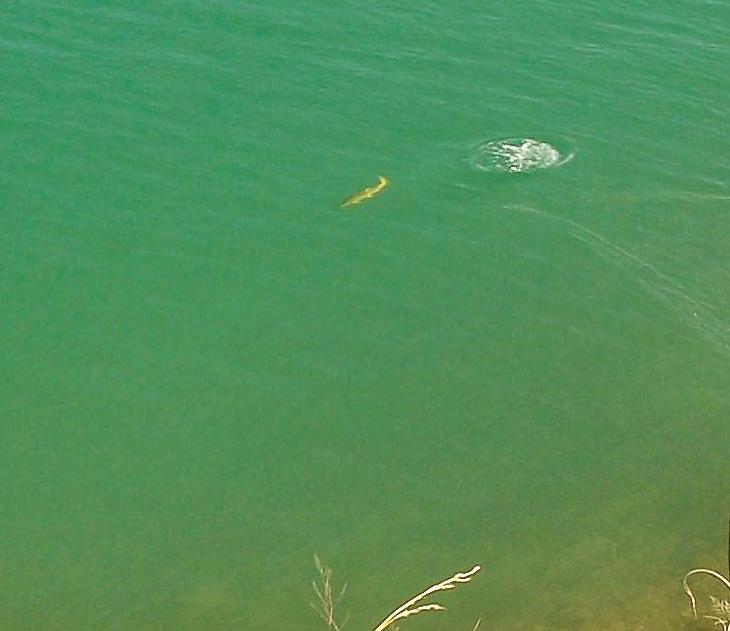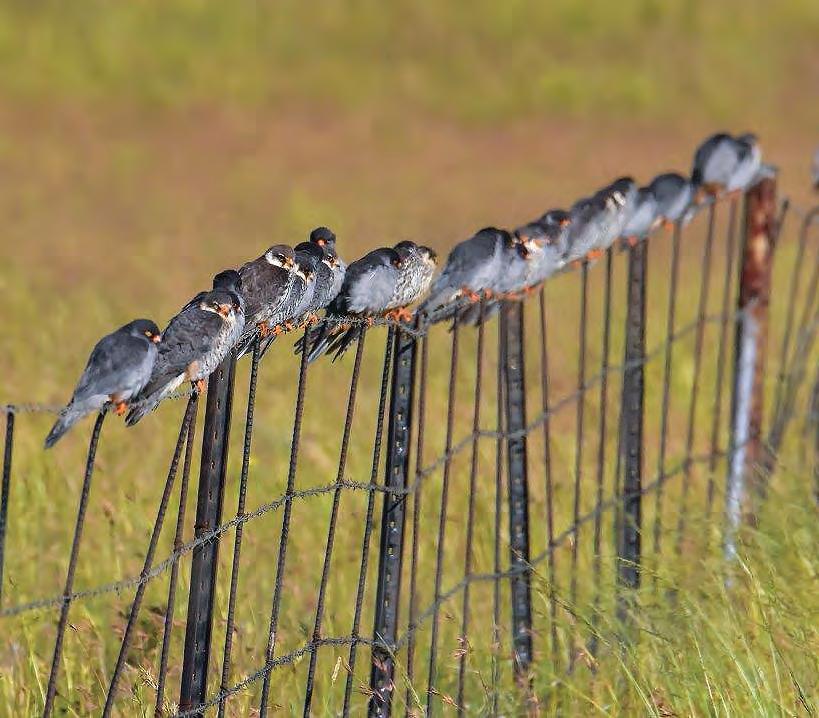
10 minute read
Birds and Flyfishing
By David Weaver
I was exceptionally lucky to grow up in a fishing family. Every holiday was planned around flyfishing and fishing destinations. Even our mid-winter hunting trip to Kimberley saw us boys casting flies to yellows on the Vaal. The second piece of good fortune was that my father was a birder. We always had the birds shown to us during time spent on the water with him, whether fishing the streams of the Cape, the municipal dam at Dullstroom or casting spoons for tail (yellowtail) from the slopes. We learnt the names and we learnt the signs.
Advertisement
I will share these secrets with you in this article and shed some light on how being aware of the behaviour of birds might help you find more fish.
Fishing and birding complement one another and each takes you to places where you can do one or the other. The difference between the two is that anglers just go fishing, but as a birder you are always birding. I always take a rod with me when I go on birding holidays and I am always birding when I go fishing. When we went to the Victoria Falls to get the bat hawk, palm thrush and rock pratincole I caught some great feisty tigers in the rapids above the Falls and even got to meet Steve, the local flyfishing dude. On a trip to St Brandon’s I got to see one of my “bucketlist” birds, the fairy tern, while doing battle with bonefish on the flats and endlessly stalking permit. At Popa Falls, on the Kavango River, we ticked brown firefinch, wwamp boubous and the elusive sharp-tailed starling for my Southern African List and caught some great purple largemouths and nembwe. On a trip to the Caprivi and drifting down the Zambezi we got up close and personal with swarms of spectacular carmine beeeaters and watched in awe as African skimmers drew perfect lines on mirrored surfaces. I can link many lifers (the first time one sees a species) with fishing trips; they add colour and song to a good day on the water.
Sterkfontein Dam has been my home water for the last 20 years, and yellowfish have been my focus. Working as a flyfishing guide during the summer months means I get to spend many hours on the waters of this magnificent fishery. This also feeds my passion as a birder as I get to observe the behaviour and distribution of the bird species that frequent Sterkies. This has helped me as a fishing guide as I have often been able to locate fish by observing what the birds are doing.
Let’s start by looking at some of the more obvious examples away from Sterkies where birds help us to locate fish.
At sea your skipper, if he’s worth his salt (pun intended), will always be looking for bird activity to locate shoals of baitfish. Terns will be a good indication of smallish fish while gannets and cormorants are an indicator of bigger fish species. There will be gamefish to target where birds are feeding on baitfish. You may even want to consider matching your fly to the bird. Terns are an indicator of smaller baitfish, thus smaller flies are required, while gannets and cormorants indicate bigger fish and thus suggest a change to bigger flies.
On the Okavango, especially when fishing the barbel run, you want to be constantly looking out for bird activity. As the shoals of barbel herd baitfish up against the papyrus banks, the piscivores (birds that eat fish) of the swamps will be there in numbers. Little-, intermediate- and great white egrets will form the bulk of the flock, while grey- and Goliath herons, storks and even fish eagles will hang on the margins. The bird activity will get you on the money as you will find the tigers cleaning up behind the barbel — that’s why you spent good money to be standing on the bow of that skiff with your rod in your hands, your line at your feet and your heart in your mouth. Even if you don’t hook in to that double figure tiger it’s still an awesome sight to see the feeding frenzy caused by fish and birds.

BIRDS AND STERKIES People often ask me when the best time is to be fishing for yellows on Sterkies. I never give a date as I don’t believe that nature watches a
calendar. My standard response is that we start fishing when the Piet-my-vrou (red-chested cuckoo) starts calling and the season ends when the Amur falcons leave. That is, roughly speaking, from mid-October to late March.
The red-chested cuckoo is a brood parasite to the Cape robin-chat, so their calling will coincide with the start of the breeding cycle of the robins. The robins won’t start breeding until there is enough insect activity to make feeding their young a viable option. If the rains are late the insects don’t breed, the robins don’t nest, and the cuckoos aren’t singing their hearts out looking for a mate.
No insect activity also means that the yellows will still be in deep water eating snails and bloodworm and won’t be in the shallows snacking on beetles and hoppers. It all makes sense when you take the trouble to crack the code.
Amur falcons are our indicator at the other end of the season. They visit us from the Amur Valley in Mongolia where they breed and then they fly south to spend the austral summers here in Southern Africa. To get back to Mongolia they do the longest trans-oceanic crossing of any terrestrial species — they fly overland to Somalia and then hang a right across the Arabian sea, only reaching land when they get to the Indian sub-continent.
To survive this incredible crossing, they need to have enough reserves for the trip. Termites supply them with enough high energy food to last them on their journey. Near the end of summer here in the eastern Free state we get spectacular termite alates (the mating flight of the termites); the Amurs get fat and ready to fly, and so do the yellows. After the termite feast the Amurs leave and the yellows go who knows where.
Late in the season I am always on the lookout for these termite alates. The first trick is to observe where there are plenty of termite mounds and be aware that you will need an off-shore wind to blow them onto the water. Then, in the late afternoon, especially after a thunderstorm, be on the lookout for bird activity. It is not only the Amurs that make use of this


A wet greater striped swallow.
feast, but all birds. All terrestrial species like redwinged starlings, weavers, cisticolas and bulbuls will be flying vertical sorties to catch termites and then dropping straight back down to enjoy the feast. The swallows and swifts will be flying low over the grass in erratic lines as they swerve back and forth catching these poor fliers. Get to the shore closest to this activity and you can experience an awesome session as the yellows rise freely to drowning termites.
Throughout the summer mornings other species of ants are hatching, especially after good rain the previous day. Ball-biters, small termites and black ants hatch in swarms. These smaller insects seldom attract the interest of the Amurs, but the swifts, swallows and other “aerial arthropod” hunters are drawn to these hatches. The tell-tale sign that a “small” ant hatch is taking place is when you see these species flying low over the grass.
If you spot that, get ready and change to a small CDC ant as yellows love an ant on the water. Look out for porpoising fish sipping these guys off the surface, cast ahead of the feeding wolves and spectacular dry-fly action awaits. The ants are often trapped in the scum lines that bend around the points, so if you missed the actual hatch you can still find fish feeding along the scum lines. Sit still, conceal yourself and wait patiently for those cruisers to come past.
African fish eagles, ospreys and white-breasted cormorants are the large piscivores found on Sterkies, so very their presence can often alert you to the presence of fish. They can, however, spell doom on a good session. Often we have been stalking fish in the shallows when suddenly they all scatter into the deep. You turn around expecting some Wally to be breaking the skyline or wandering over to ask you what fly you caught that last fish on, only to see a fish eagle hovering above you. Don’t curse, just enjoy the spectacular antics of one of Africa’s iconic birds. And if it was Wally, there are no limits to

42 • Return to contents The take.



Drinking on the fly.

Amur falcons.


Join us on Facebook the expletive crudities that you are permitted to throw in his direction.
Red-knobbed coots are found in large flocks on Sterkies and many other inland waters. They are indicators of weed beds. They dive down and collect aquatic weed to eat. As they pull the weed from the water they disturb aquatic insects, and as the fish know this they hang with the coots. “Fish where there be coots and your creel will neigh be empty,” was an expression my dad drilled into us. I still live by that credo and it has served me well.
Weed equals food for insects, equals food for hungry trout and yellows. Weed also offers structure for ambush predators like bass and largemouth yellowfish that hunt the smaller fish seeking cover in the vegetation. The weed in Sterkies has a large population of snails which are prime yellowfish food, so fishing the windward side of a strong weed bed with a snail pattern will often produce fat fish.
Swallows and martins can fly slower than swifts and will often feed on aquatic invertebrates as they hatch from the smorgasbord that is Sterkies. You might think that they are just sipping water, but if you look more closely you will notice that they are catching emerging caddis and mayflies. Be warned though, a perfectly presented Klippies-en-Gans did once fool a feeding swallow. An interesting fight and a safe release followed; I think we were more shaken than the young barn swallow. The incident also emphasised the importance of fishing barbless hooks.
You should never fish near spawning yellows. In fact, it’s best to stay away from the spawning beds altogether; their eggs do not take kindly to being stomped on. The splashing in the shallows and general mayhem normally makes the spawning beds easy to spot. The presence of Cape wagtails is another tell-tale sign, especially when the yellows are not actually in the throes of a spawn. Cape wagtails eat yellowfish eggs and will alert you to spawning fish.
We flyfish for many reasons, each for his or her own sanity, I believe. I flyfish because it takes me to spectacular places and I bird because birds afford me the chance to dream of free flight and allow me to escape the mundanity of everyday life. I bird while I fish, and I fish while I bird. When the two activities collide and shed clarity on the complexities of our wonderful pasttime then we are left in awe and stand humbled before all that is great around us.
Thank you, Dad, for allowing me to see beauty and connectedness in the world … now it is our duty to share this with those that walk this path behind us.





